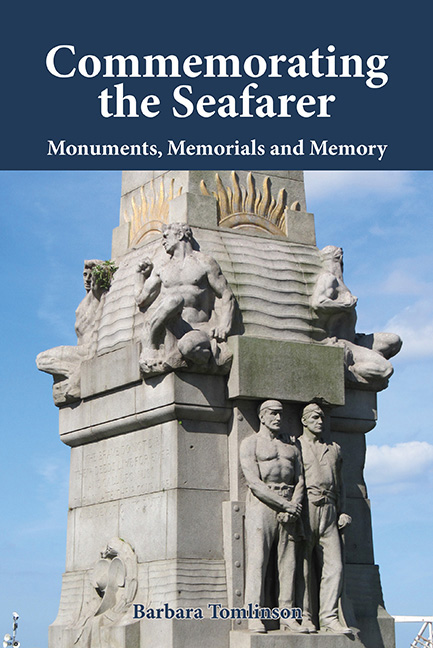Book contents
- Frontmatter
- Dedication
- Contents
- Illustrations
- Preface
- Acknowledgements
- Introduction
- 1 Shifting Loyalties: Naval Memorials, 1628–783
- 2 The Age of Heroes: Naval Memorials, 1783–815
- 3 Pax Britannica: Naval Memorials, 1815–914
- 4 Stormy Weather: Conflict and Sacrifice in the Twentieth Century
- 5 Commerce and Philanthropy: Mercantile Commemoration
- 6 Lost at Sea: Maritime Accidents
- 7 Maritime Explorers: Drake to Shackleton
- 8 Inshore: Fishermen, Lifesavers and Leisure
- Conclusion
- Bibliography
- Index
- Frontmatter
- Dedication
- Contents
- Illustrations
- Preface
- Acknowledgements
- Introduction
- 1 Shifting Loyalties: Naval Memorials, 1628–783
- 2 The Age of Heroes: Naval Memorials, 1783–815
- 3 Pax Britannica: Naval Memorials, 1815–914
- 4 Stormy Weather: Conflict and Sacrifice in the Twentieth Century
- 5 Commerce and Philanthropy: Mercantile Commemoration
- 6 Lost at Sea: Maritime Accidents
- 7 Maritime Explorers: Drake to Shackleton
- 8 Inshore: Fishermen, Lifesavers and Leisure
- Conclusion
- Bibliography
- Index
Summary
After a long career at the National Maritime Museum, Greenwich, the present writer has naturally been interested in the way memorials reflect the importance of the sea to the nation at large. Various economic and military imperatives have persuaded the British to risk the hazards of sea travel over the centuries, although in more recent times many have got afloat for the sheer fun of it. A large number of memorials are to those whose voyages ended in disaster: young men who died prematurely, several generations wiped out in the loss of family-owned vessels, entire families drowned in the wreck of passenger ships. For others, the sea offered an occupation which gave status or a reasonably prosperous livelihood, something their family or friends saw as an important part of their identity when seeking to commemorate them.
Memorial types
The most expensive and prestigious memorials were those erected by the monarch or the state. Public memorials to naval commanders came late to Great Britain and the pantheon of national military heroes in St Paul's Cathedral and Westminster Abbey has been extensively researched by Holger Hoock and Matthew Craske. Although commissions went to architects and sculptors of the highest quality, some of the officers they celebrated are now largely forgotten. By the later nineteenth century there was an enthusiasm amongst prosperous citizens (undiminished to this day) for erecting memorials to the long dead, particularly in the form of civic sculpture. This is a good indicator of those historic figures who retained or regained their popularity. Universal education, changing values, national and local identity, not to mention tourism, all played a role in these manifestations of collective memory. War memorials, state or civic, enjoy an increasingly revered status as representing the community rather than the individual. As time has passed, however, they have also come under threat from neglect, vandalism and metal theft: not everyone buys into the idea of individual sacrifice on behalf of the nation.
The Royal Navy dominated maritime art and iconography in Britain from the seventeenth century onwards. Before then, and long after, the division between commerce and warfare at sea was not clear-cut.
- Type
- Chapter
- Information
- Commemorating the SeafarerMonuments, Memorials and Memory, pp. 1 - 6Publisher: Boydell & BrewerPrint publication year: 2015



